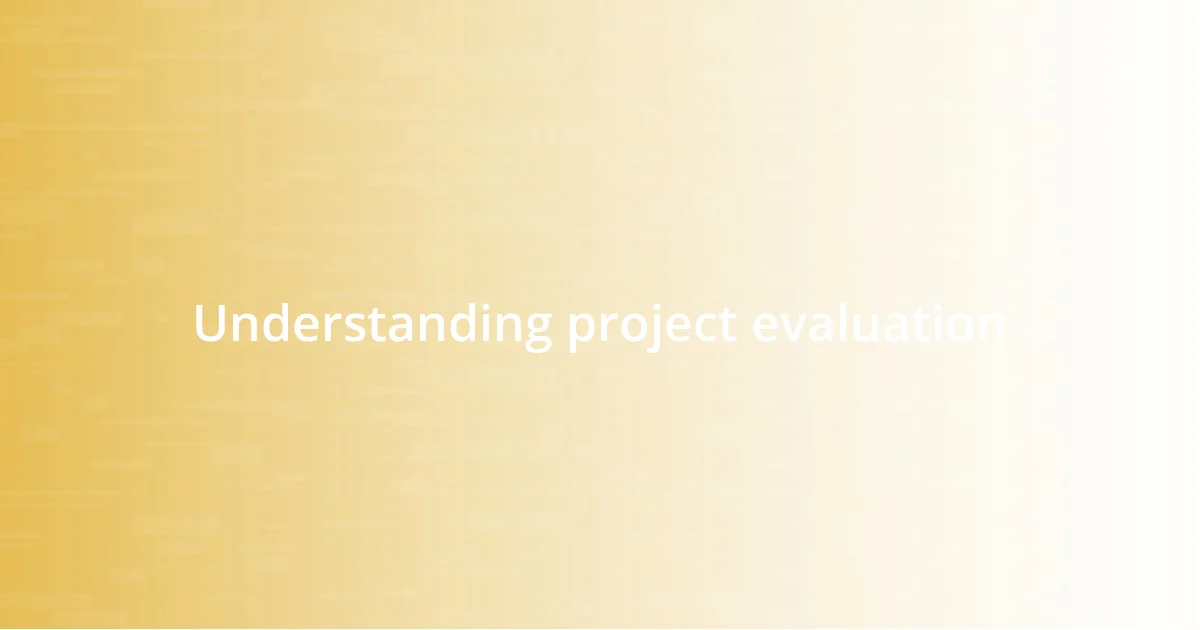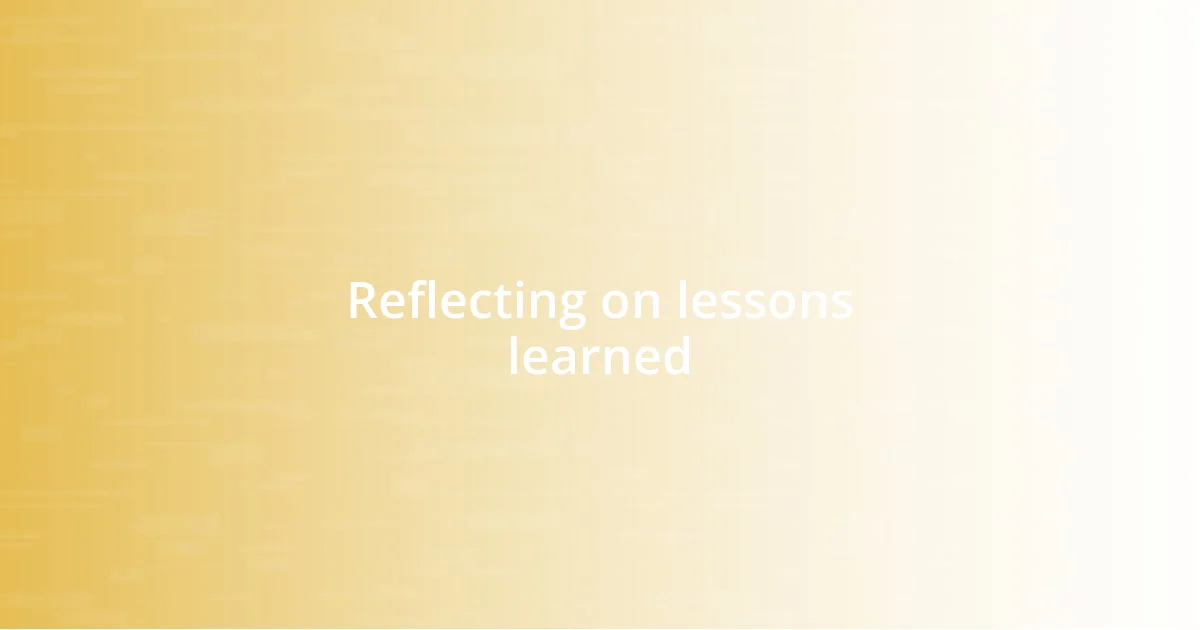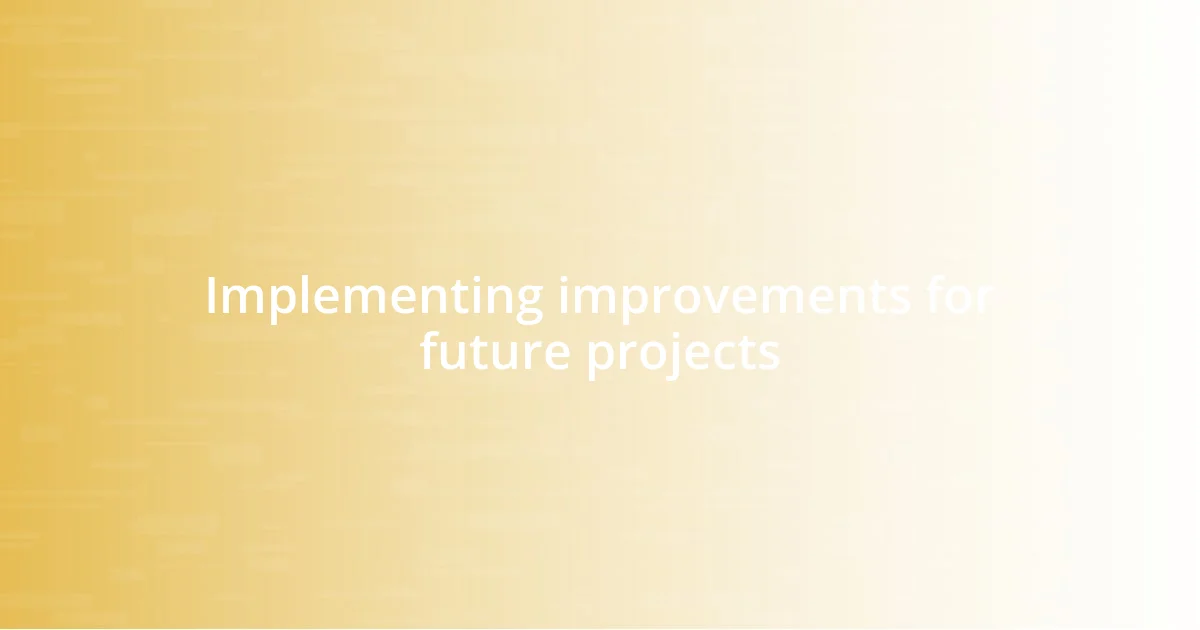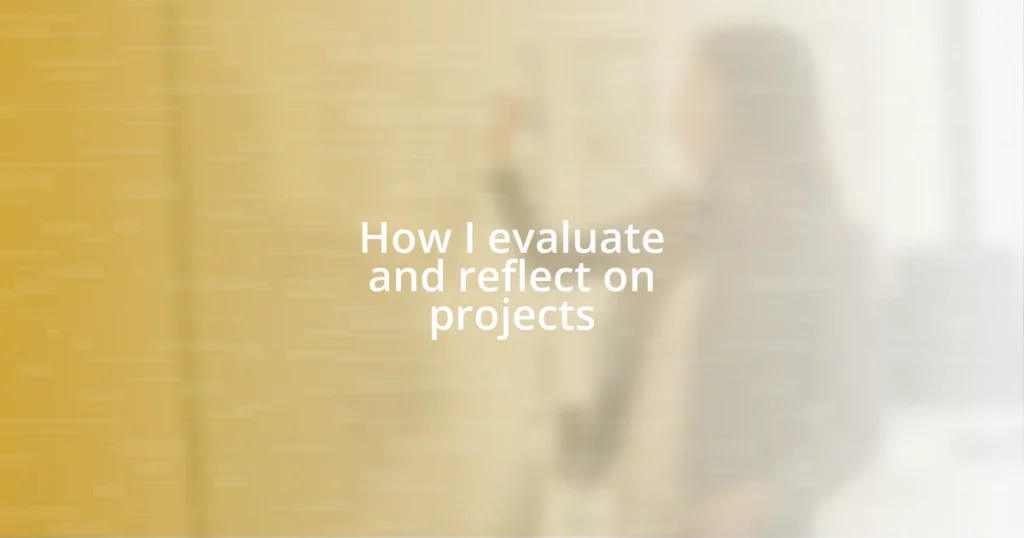Key takeaways:
- Effective project evaluation involves not only assessing outcomes through metrics but also understanding the emotional and narrative aspects of the team experience.
- Setting comprehensive evaluation criteria, incorporating both qualitative and quantitative feedback, enhances the ability to identify successes and areas for improvement in future projects.
- Documenting the evaluation process, including personal reflections, fosters deeper understanding and discussion within the team, leading to meaningful insights and emotional support for continuous growth.

Understanding project evaluation
Understanding project evaluation goes beyond simply assessing outcomes; it’s about grasping the entire process and experience involved. I remember a time when I completed a complex marketing campaign. The final numbers looked impressive, but it was the feedback sessions with my team that revealed both strengths and weaknesses in our approach, which I found invaluable.
When I think of project evaluation, I often ask myself: What did I truly learn from this experience? Evaluating a project allows for richer insights that numbers alone can’t convey. Reflecting on my emotional reactions throughout a project, I realized that moments of frustration often led to significant breakthroughs in understanding the project’s dynamics and potential.
Every project has its unique narrative, and it’s essential to learn how to tell that story. The conversations I have with my team help illustrate this. For instance, discussing what went wrong not only highlights areas for improvement but also builds a stronger sense of community and shared purpose. Have you ever experienced a project that shifted your perspective on teamwork? Those reflections can deeply influence future endeavors.

Setting evaluation criteria
Setting effective evaluation criteria is a crucial step in understanding the success of any project. I remember once working on an event coordination project, where I was tasked with organizing a company-wide retreat. Initially, I thought the success would be measured solely by attendance numbers. However, I soon realized that gathering feedback on participant satisfaction and engagement was equally important. It was eye-opening to see how these criteria shaped our ability to improve future events based on real attendee experiences.
When establishing evaluation criteria, it’s helpful to consider various factors that may influence outcomes. Here’s a concise list of aspects I prioritize:
– Clear Objectives: What were the primary goals of the project?
– Stakeholder Feedback: How did key participants feel about the process?
– Budget Adherence: Did we stay within the financial plan?
– Timeliness: Was the project completed on schedule?
– Quality of Deliverables: Did the outcomes meet our standards?
By thoughtfully determining these criteria, I find it much easier to reflect on what worked well and what needed adjustment, leading to continuous growth in my project management journey.

Collecting data and feedback
Collecting data and feedback is an essential part of project evaluation. I often find that the most valuable insights come from unexpected sources. Once, during a software development project, I initiated a casual feedback session with my team. To my surprise, a simple conversation revealed vital issues that didn’t emerge in formal reports. It’s these candid, informal discussions that often spark the most profound insights.
In my experience, combining qualitative and quantitative data creates a more rounded picture of project performance. For example, after launching a new product, I gathered survey results alongside anecdotal feedback captured during informal team lunches. The data showed one thing, while the feedback shared emotions and stories that numbers could never convey. Balancing these two sources of feedback helps me truly understand the impact of my work.
To streamline the data collection process, I’ve found it effective to create a feedback template. This includes structured questions that encourage thoughtful responses, but also leaves room for open-ended insights. My template often goes beyond standard questions, allowing team members to share any lingering thoughts or feelings. It might feel like a small step, but this practice has been a game-changer for gathering meaningful feedback and fostering an open communication culture.
| Method of Feedback Collection | Strengths |
|---|---|
| Surveys | Provides quantitative data; easy to analyze |
| Informal discussions | Reveals deeper insights and emotions |
| Structured templates | Guides responses, encourages completeness |

Analyzing outcomes and impacts
Analyzing outcomes and impacts goes beyond just numbers; it’s about understanding the narrative behind those results. I vividly recall a community outreach project where, despite hitting our attendance goals, I was troubled by lingering feedback about the event’s relevance. Would you believe that a simple follow-up survey revealed that many participants felt disconnected from the content? This realization forced me to rethink how I aligned our activities with community needs, highlighting the importance of contextualizing our success metrics.
In my experience, a crucial part of this analysis is comparing expected outcomes with real results. After a marketing campaign, I felt proud when our reach exceeded estimates. Yet, reflecting deeper, I noticed that our engagement rates didn’t match that enthusiasm. It’s almost like hosting a party where everyone shows up but few stay to enjoy themselves. Did we miss the mark in connecting with our audience? This mismatch prompted a need for more targeted messaging in future campaigns.
Utilizing reflective practices, like post-mortem meetings, has been instrumental for me in analyzing projects. I can still picture a brainstorming session with my team after a product launch where we dissected every aspect—what worked and what bombed. The discussion got surprisingly emotional; we shared not just facts but our feelings about missed opportunities and moments of triumph. This collective reflection not only illuminated lessons learned but also brought us closer as a team. The power of analyzing outcomes isn’t merely in what the data reveals but also in how those insights shape our future endeavors.

Reflecting on lessons learned
Reflecting on lessons learned is not just a matter of noting what went wrong or right; it’s about fostering a mindset of continuous growth. I remember a project where we faced significant delays due to unforeseen technical issues. Sharing those frustrations with my team opened a floodgate of reflections, leading us to realize that our planning phase lacked thorough risk assessments. It made me ask myself: why didn’t we anticipate these hurdles? This reflection has since changed my approach to planning, making me more proactive in identifying potential pitfalls.
One of the most eye-opening moments for me came when I coordinated a workshop that didn’t attract the participants we had hoped for. Initially, I felt defeated and defensive, but diving deeper into the feedback revealed a disconnect between our topics and audience interests. Why hadn’t I engaged with potential participants earlier? This realization taught me the value of involving stakeholders right from the conceptual stage. It was a poignant reminder that engaging others in reflection can unlock insights that I might overlook alone.
Incorporating lessons learned into future projects feels almost like a dance of sorts—one step forward, another backward, but always moving toward improvement. I cherish the moments when I assess my own emotional responses to projects. Do I feel excited or drained after a meeting? These emotions serve as indicators, guiding me to where I need to pay more attention. By reflecting on my feelings, I create a more holistic view of project evaluation, reminding myself that emotional insights often hold the key to understanding the broader impact of my work and how to navigate future projects more thoughtfully.

Implementing improvements for future projects
After completing a project, I always find myself pondering how we could elevate our approach. I distinctly remember a time when we developed a software tool that, while functional, garnered complaints about the user interface. Reflecting on that, I implemented a cycle of user testing early in development for our next project. How could we have overlooked the perspective of our end-users initially? Recognizing the need for early feedback transformed our process and resulted in a product that was exponentially more user-friendly.
I also believe firmly in the importance of creating feedback loops within the team. During a recent project debrief, I introduced a new practice of open feedback sessions where each team member could voice their thoughts on our collaborative processes. It was empowering to hear everyone share their experiences, particularly when someone revealed how unclear communication led to duplicated efforts. Reflecting together on these hurdles not only nurtured our relationships, it sparked an initiative for more structured communication in future collaborations. Could it be that our obstacles were actually pathways to stronger teamwork?
In observing how past projects unfolded, I’m continually reminded of the emotional impact they have on everyone involved. For instance, there was a time when a project didn’t meet our objectives and left the team feeling disheartened. But instead of brushing those feelings aside, we spent time unpacking what went wrong and how it affected us personally. This practice illuminated not just the technical flaws but also the emotional weight we carried as a team. Isn’t it fascinating how our feelings can inform future strategies? By embracing those emotions, I’ve made it a priority to foster a more supportive atmosphere where everyone feels valued and heard—a crucial ingredient for success in any project.

Documenting the evaluation process
Documenting the evaluation process goes far beyond mere notes; it’s about creating a narrative that captures the essence of what we learned. I recall a time when I decided to keep a journal throughout a sizable project. In it, I not only noted key decisions and outcomes but also my feelings during pivotal moments. This approach allowed me to revisit not just what happened, but how it felt—which, honestly, added layers of understanding to our outcomes.
One of the unexpected benefits of this documentation was how it prompted deeper reflections during team meetings. I would often share excerpts from my journal, and watching how my colleagues reacted stirred meaningful conversations. For instance, there was an instance when I documented a moment of anxiety before a crucial presentation. When I shared this, a teammate revealed they felt the same way. This shared vulnerability transformed our dialogue into an opportunity to discuss preparation strategies and emotional support, enriching our future collaboration.
As I sifted through my notes after the project, I was struck by patterns I hadn’t noticed before. Certain phrases or feelings kept cropping up—are these signs pointing to something more significant? By systematically documenting not just the logistics but also our emotional landscape, I discovered insights that truly guided our future projects. It’s fascinating how taking the time to document can turn seemingly chaotic experiences into a coherent story of growth and improvement. Isn’t it rewarding to see how reflection can bridge the gap between mere tasks and genuine learning?















